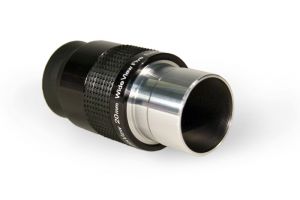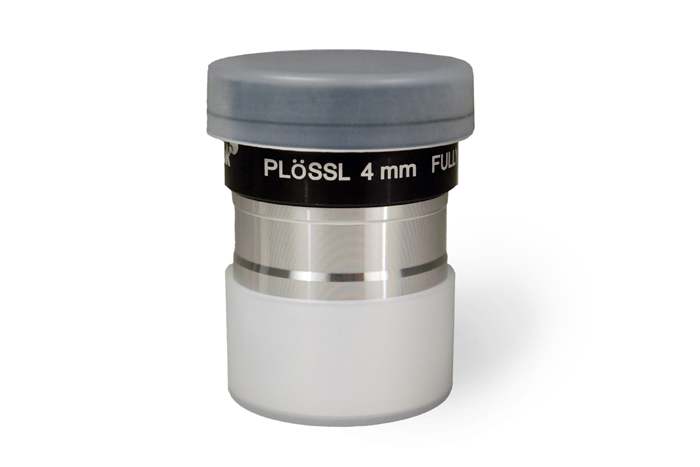Кратко ръководство за избор на окуляри
CAUTION!
Never look directly at the Sun — even for an instant — through your telescope or finderscope without a professionally made solar filter that completely covers the front of the instrument, or permanent eye damage may result. To avoid damage to the internal parts of your telescope, make sure the front end of the finderscope is covered with aluminum foil or another nontransparent material.
Children should use the telescope under adult supervision only.
The main goal of any telescope eyepiece is to form a sharp image, focusing the light rays collected by a telescope. Difficulty in choosing the right eyepiece is also related to the telescope’s focal ratio – the smaller the focal ratio of your telescope, the better eyepiece you have to use. For example, with an f/10 telescope you can use almost any decently made telescope eyepiece and you will obtain quality, sharp views. But if you use an f/4 instrument, you have to combine it with only the best examples of modern optical systems in order to achieve image clarity across the entire field of view.
Eyepiece optical design determines its eye relief (distance from the eyepiece lens to the eye of the observer with a clear image). An observer who wears eyeglasses will need about 15-20mm eye relief value in order to see the entire field of view of the eyepiece. In traditional optical designs, eye relief is proportional to focal length: the shorter the focal length, the shorter the eye relief. However, some modern eyepieces offer an excellent eye relief at short focal lengths.
Eyepiece optical design also determines its apparent field of view. The apparent field of view is the angular diameter of the circle of light seen by the human eye expressed in degrees. Most conventional eyepieces have 40-50° apparent fields of view. The true field of view (the angular diameter of the sky area visible through the eyepiece) can be found by dividing the apparent field of view by the magnification of the telescope with this particular eyepiece. Let’s suppose that we have a telescope with an aperture diameter of 200mm, 2000mm focal length, and an eyepiece with 20 mm focal length and 50° apparent field of view. In this case the magnification will be 2000mm / 20mm = 100x, and the true field of view equals 50° / 100x = 0.5° (which is one angular diameter of the full moon).
Eyepieces with earlier optical designs (Huygens, Ramsden) and microscope eyepieces have an apparent field of view of just 30°. Newer eyepieces have 60° and even more. If you switch from a 30° eyepiece to a 60° eyepiece at the same magnification, you will be able to see a field of view that is twice as wide. That’s why some observers spend a lot of money on wide-angle eyepieces that provide ‘spaceship porthole’ views.
Eyepiece Designs
Huygens. This eyepiece design was invented by Christiaan Huygens in the 17th century. This two-element design is now considered outdated, but sometimes such eyepieces (marked with capital ‘H’) are supplied together with cheap telescope models. Eye relief and field of view are quite small. Ramsden eyepiece design, which is a modified version of the Huygens eyepiece design, is much more efficient but is also outmoded (although still used in some microscopes).
Kellner. Three-element Kellner (and its close modifications - Achromatic Ramsden “AR” and Modified Achromatic “MA”) are considered to be the least expensive eyepiece for serious astronomy. Such eyepieces provide bright and clear images at small and medium magnifications. Kellner eyepieces work perfectly with small and medium-sized telescopes. These eyepieces have about 40° apparent fields of view and reasonable eye relief, though quite short for high magnifications.
Orthoscopic. The four-element orthoscopic eyepieces were once considered the best eyepieces for universal use. But now such optical design clearly loses the competition to more recent designs because of its quite narrow field of view. Orthos provide excellent clarity, color correction, contrast, and larger eye relief than Kellner eyepieces. They are especially good for lunar and planetary observations.
Plössl. The four-element Plössl design is the most popular eyepiece optical design that gives you excellent image quality, good eye relief, and a 50° apparent field of view. High-quality Plössl eyepieces provide high contrast and sharpness across the entire field of view. They are suited for any king of observation.
Erfle. The 5- or 6-element Erfle eyepieces are optimized for a wide apparent field of 60° to 70°. At low magnification these eyepieces produce spectacular views of stellar fields. At high magnifications the edge-to-edge clarity suffers a little.
Ultra Wide Angle Eyepieces. This group includes improved optical designs consisting of 6-8 elements and featuring wide fields of view up to 85°. It is so wide, you have to rotate your eye to see the whole panorama (by the way, not everyone loves it). Additional elements slightly increase light loss inside the eyepiece, but in general the resulting image quality is very high. So is the price.
 Thus, to choose the right eyepiece design, you need to determine what objects you plan to observe, the importance of impeccable image quality and large field of view, and, finally, how much money you are willing to spend.
Thus, to choose the right eyepiece design, you need to determine what objects you plan to observe, the importance of impeccable image quality and large field of view, and, finally, how much money you are willing to spend.
There are three standard barrel diameters for telescope eyepieces: 0.965" (24.5mm), 1.25" (31.75mm) and 2" (50.8mm). The smallest size is commonly used on cheap telescopes that you can find in the closest department store. Most amateur telescopes have a 1.25" barrel diameter, while 2" is typical for high-quality, large telescopes that offer a wider field of view and better image quality.
To align a finderscope with the main telescope, set the polar axis using the drift method, guide exposures during astrophotography, or measure small angles, you will need an illuminated reticle eyepiece. Such eyepieces have a special grid at the focal plane illuminated by a small incorporated variable brightness LED light.
Each telescope model has limited useful magnification power. When this limit is exceeded the picture starts to darken and blur. Keep that in mind when choosing an eyepiece. Magnification is calculated by dividing the focal length of the telescope by the focal length of the eyepiece. Accordingly, the focal length of the eyepiece equals the objective focal length divided by the magnification. For example, a telescope with 2000mm focal length and 20mm eyepiece will give you 100x increase.
Highest practical power of a telescope directly depends on its aperture. Large telescopes are able to collect more light, capture a broader wavefront and, therefore, produce sharper views. The magnification also determines the size of the exit pupil. The exit pupil diameter can be obtained by dividing the telescope’s aperture by its magnifications. You can also use another formula: just divide the eyepiece focal length by the telescope’s focal ratio. The exit pupil must be smaller than the diameter of the pupil of the observer’s eye; otherwise some of the light rays will not make it into the pupil. Young people have great night vision; their eyes are fully adapted to the darkness, and therefore, they have pupils about 7mm in diameter. Maximum pupil diameter decreases with age. So an average middle-aged adult has 5mm-wide pupils. On the other hand, with exit pupil diameters less than 1 millimeter so-called ‘empty magnification’ appears, meaning that the picture quality decreases very rapidly.
|
Magnification power range
|
Exit pupil diameter, mm
|
Magnification power per inch of aperture, x
|
Magnification power
(75-mm telescope), x |
Magnification power
(200-mm telescope), x |
Application
|
|
very low |
4.0 – 7.0 |
3 - 6 |
10 - 18 |
28 - 50 |
Lowest usable power. Wide-field observing of deep-sky objects in dark sky. |
|
low |
2.0 – 4.0 |
6 - 12 |
18 - 36 |
48 - 100 |
General observations, locating objects, observing most deep-sky objects. |
|
medium |
1.0 – 2.0 |
12 - 25 |
36 - 75 |
100 - 200 |
Moon, planets, compact deep-sky objects, wide double stars. |
|
high |
0.7 – 1.0 |
25 - 35 |
75 - 100 |
200 - 280 |
Moon and planets (steady air), double stars, compact clusters. |
|
very high |
0.5 – 0.7 |
35 - 50 |
100 - 150 |
280 - 400 |
Planets and close double stars (very steady air). |
So how many eyepieces do you need? Just a few. You can use one low-power and one high-power eyepiece for a long time, but eventually you will want to extend your accessory collection by adding a few more magnifications. For instance, if you have an f/10 telescope, 25mm and 9mm eyepieces would make a wonderful starter kit, and then you might want to add some 15mm and 6mm eyepieces. If you have several different eyepieces, you can find the optimal magnification for each selected object. Starting with a minimum increase when locating objects, you can lift it up until you reach the optimum picture quality. You can also use 2x Barlow lens that doubles the magnifying power of any eyepiece. Therefore, instead of a 3mm eyepiece, you can take a 6mm one and 2x Barlow lens and get the same magnification. The number of eyepieces in your accessory collection can be minimal if you have a Barlow lens among them. Just make sure that the eyepieces’ focal lengths are not multiples of the Barlow lens’ magnification.
For example, if your eyepieces are 25, 12.5, and 6 millimetres (multiples of 2), then a 2x Barlow lens will be useless; it won’t give you any additional magnifications. But if you have 25mm, 15mm, 10mm eyepieces and 2x Barlow lens, you will get three more focal lengths – 12.5mm, 7.5mm, and 5mm: practically, three additional eyepieces!
When you have a few different eyepieces and you switch them during observations in order to get a better view of an object, it might be necessary to refocus the instrument. Some eyepieces series are parfocal – that means that they have the same position of focus points. Therefore, when you change such eyepieces, refocusing isn’t required.
Забранява се всяко възпроизвеждане на материала с цел публична публикация във всякаква информационна среда и във всякакъв формат. Можете да реферирате към тази статия с активна връзка към bg.levenhukb2b.com.
Производителят си запазва правото да прави промени на цените, гамата продукти и спецификациите им или да преустанови предлагането на продуктите без предварително уведомление.




